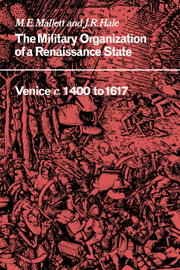Book contents
- Frontmatter
- Contents
- List of illustrations
- Acknowledgements
- References and abbreviations
- Map 1 The Terraferma in the fifteenth and sixteenth centuries
- Map 2 The empire da Mar
- PART I c. 1400 to 1508
- PART II 1509–1617
- 8 The historical role of the land forces 1509–1617
- 9 The wars
- 10 Government: policy, control and administration
- 11 The higher command
- 12 Manpower
- 13 Cavalry, infantry, artillery
- 14 Fortifications in the Terraferma
- 15 The defence of the maritime empire
- 16 The costs of defence and war
- Conclusion: the European context 1525–1617
- Appendix Infantry wages in the sixteenth century
- Select bibliography
- Index
13 - Cavalry, infantry, artillery
Published online by Cambridge University Press: 22 October 2009
- Frontmatter
- Contents
- List of illustrations
- Acknowledgements
- References and abbreviations
- Map 1 The Terraferma in the fifteenth and sixteenth centuries
- Map 2 The empire da Mar
- PART I c. 1400 to 1508
- PART II 1509–1617
- 8 The historical role of the land forces 1509–1617
- 9 The wars
- 10 Government: policy, control and administration
- 11 The higher command
- 12 Manpower
- 13 Cavalry, infantry, artillery
- 14 Fortifications in the Terraferma
- 15 The defence of the maritime empire
- 16 The costs of defence and war
- Conclusion: the European context 1525–1617
- Appendix Infantry wages in the sixteenth century
- Select bibliography
- Index
Summary
The prestige arm throughout the century, and the most resistant to change, remained the heavy cavalry, the uomini d'arme. And this was in spite of the decline in their numbers, especially after the campaigns of 1509–17, and also in spite of the realization that between 1530 and 1573 the chief likelihood of combat was amphibious warfare against the Turks, in which they could play no useful part, and that thereafter, when land war against the Spaniards or Austrians seemed more likely, heavy cavalry was universally recognized to have long outlived its usefulness.
Until 1519 they were organized in ‘lances’ each comprising three fighting men, the man-at-arms proper, riding in full plate armour (‘in arme bianche’ or ‘in biancho’ or ‘in albo’) on a barded horse, the others more lightly armed with lance or crossbow and riding unbarded horses. In each ‘lance’ there was a fourth horse, of inferior quality, ridden by the man-at-arms' servant and carrying baggage. A company of 50 men-at-arms thus contained 150 righting men and 200 horses, the combatants and their horses being the only ones counted for pay purposes. In practice, ‘lances’ were seldom up to strength and in 1519 the number was cut; henceforward they were to comprise the man-at-arms riding his war charger (capo di lanza or caval grosso), one squire or saccomano armed as a light cavalryman but on a horse (primo piatto or corsier) capable of acting as the man-at-arms' reserve, and a servant on a ronzin, terzo or bagaglione; two fighting men, that is, and three horses, ‘as was the custom before the war’.
- Type
- Chapter
- Information
- The Military Organisation of a Renaissance StateVenice c.1400 to 1617, pp. 367 - 408Publisher: Cambridge University PressPrint publication year: 1984



